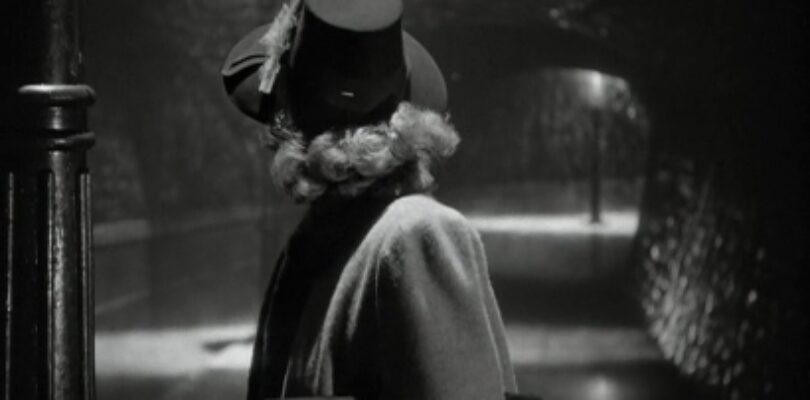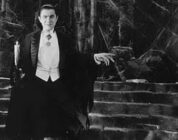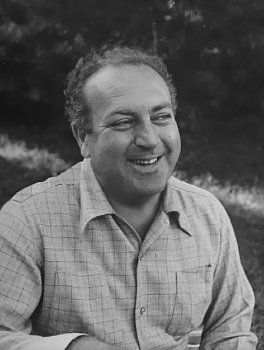 In 2005 Turner Home Entertainment released a box set of nine films from producer Val Lewton. Producers don’t usually get singled out for their influence on films and no other producer has had his work packaged in a box set. That all the films in this collection were made as “B” horror pictures is a remarkable testament to what can be done when the right person has a vision that can be put onto film. That a producer could have such an influence on his films speaks to the creative genius of Val Lewton.
In 2005 Turner Home Entertainment released a box set of nine films from producer Val Lewton. Producers don’t usually get singled out for their influence on films and no other producer has had his work packaged in a box set. That all the films in this collection were made as “B” horror pictures is a remarkable testament to what can be done when the right person has a vision that can be put onto film. That a producer could have such an influence on his films speaks to the creative genius of Val Lewton.
After apprenticing under David O. Selznick and working on such films as Gone with the Wind, Rebecca, and King Kong, Lewton was hired by RKO to head its horror film unit. RKO had been essentially bankrupted by Orson Wells’ Citizen Kane and The Magnificent Ambersons and wanted cheaply produced films to compete with the popular Universal Pictures horror films. Lewton worked from a budget of $150,000, a running time limit of 75 minutes, shooting schedules of only three weeks, and had to use pre-tested titles that were given to him by the studio. Other than that, he was free to do what he wanted. For this he was paid $250 a week.
Lewton’s attitude was that he was going to give them something different from the “monster movies” they were expecting – he was going to do the kind of suspense movies he liked and produce “A” quality pictures in his style.
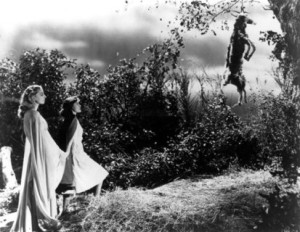 Lewton developed stories for his films then handed them over to the scriptwriters. After the first draft his team would assemble to brainstorm and critique the script. Lewton would then re-write the scripts, never taking credit away from the original writers (although he did use an assumed name on some of the films). Lewton was involved in every aspect of the film’s production: casting, locations, wardrobes, set design, and lighting. Once filming began he never interfered with the director, letting him shoot the film and direct the actors the way he thought best.
Lewton developed stories for his films then handed them over to the scriptwriters. After the first draft his team would assemble to brainstorm and critique the script. Lewton would then re-write the scripts, never taking credit away from the original writers (although he did use an assumed name on some of the films). Lewton was involved in every aspect of the film’s production: casting, locations, wardrobes, set design, and lighting. Once filming began he never interfered with the director, letting him shoot the film and direct the actors the way he thought best.
Lewton may have had limited budgets and shooting schedules but he did have the use of RKO’s back lots and sets as well as the studio’s stable of contract players. For his first films he hired friend Jacques Tourneur to direct and recruited editors Robert Wise and Mark Robson, both of whom worked on Citizen Kane and The Magnificent Ambersons. He also hired cinematographer Nicholas Musuraca who was schooled in the German Expressionist style that was perfectly suited to Lewton’s films.
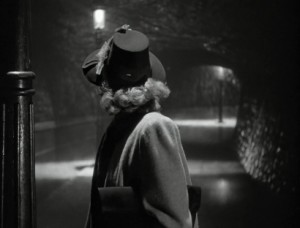 Lewton’s ideas for horror started with a dislike for what he called “monster movies.” “Monster movies” like the ones made by Universal Pictures who Lewton called “The goon school of horror movies.” He eliminated as many clichés of the horror genre as possible while keeping some of the recognizable conventions required for a successful horror film. Lewton did have an appreciation for the horror classics Dracula, Frankenstein, and Dr. Jekyl and Mr. Hyde, but was drawn more to the gothic novels and ghost stories of Victorian England that placed an emphasis on the “unseen terror.” Lewton combined romance, suspense, mystery, and murder with characters that were intense, psychologically complicated, melancholy, reflective, and pessimistic. His characters are versions of the classic noir protagonist: alienated, obsessive, and doomed.
Lewton’s ideas for horror started with a dislike for what he called “monster movies.” “Monster movies” like the ones made by Universal Pictures who Lewton called “The goon school of horror movies.” He eliminated as many clichés of the horror genre as possible while keeping some of the recognizable conventions required for a successful horror film. Lewton did have an appreciation for the horror classics Dracula, Frankenstein, and Dr. Jekyl and Mr. Hyde, but was drawn more to the gothic novels and ghost stories of Victorian England that placed an emphasis on the “unseen terror.” Lewton combined romance, suspense, mystery, and murder with characters that were intense, psychologically complicated, melancholy, reflective, and pessimistic. His characters are versions of the classic noir protagonist: alienated, obsessive, and doomed.
By today’s standards these films would seem remarkably harmless and lacking in horror. But they are illustrative of the difference between horror and terror, the difference between revulsion and fear, between the seen and the unseen. The psychological depth of the films was unheard of in films of that era – especially in the horror genre. The characters do not run from the darkness but are instead drawn to it. They seek answers in the unknown despite the unease, dread, and terror inside them. And it is this terror, elusive and mysterious, that we are drawn to. “If you make the screen dark enough,” said Lewton, “the mind’s eye will read into it anything you want.”
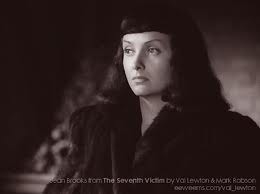 While the nine films Lewton made for RKO made him the darling of critics – then and now – they were not all box office hits and his relationship with the studio was shaky. After Lewton’s final RKO production, Bedlam, the studio went through a management upheaval and Lewton was out of a job. He spent some time at Paramount and at MGM getting only three of his pictures made during the next five years. He never again achieved what he had with his “B” pictures at RKO. After suffering two heart attacks Lewton died in Hollywood in 1951. He was 46 years old.
While the nine films Lewton made for RKO made him the darling of critics – then and now – they were not all box office hits and his relationship with the studio was shaky. After Lewton’s final RKO production, Bedlam, the studio went through a management upheaval and Lewton was out of a job. He spent some time at Paramount and at MGM getting only three of his pictures made during the next five years. He never again achieved what he had with his “B” pictures at RKO. After suffering two heart attacks Lewton died in Hollywood in 1951. He was 46 years old.
Listed below, in chronological order, are the nine horror films of producer Val Lewton.
____________________________________________________________
Cat People
(Jacques Tourneur, 1942)
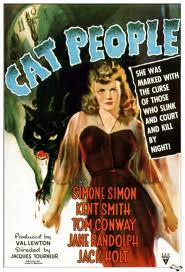 Lewton brought RKO his first film, Cat People, in 1942. It was not what RKO was looking for and they didn’t like it. The film’s star, Simone Simon, was the subject of more rumors than any other actress at that time – she was William Randolph Hearst’s love child, she wasn’t really French and was faking her accent – and was known as being moody and temperamental. But Lewton loved her. Simone’s character, Irena Dubrovna, is walking the fine line between sanity and insanity, sensing something evil within herself, thinking she was one of the evil creatures from her native Serbia that transforms from human into a deadly cat. As it turns out she is right and she slowly gives in to her true animal self.
Lewton brought RKO his first film, Cat People, in 1942. It was not what RKO was looking for and they didn’t like it. The film’s star, Simone Simon, was the subject of more rumors than any other actress at that time – she was William Randolph Hearst’s love child, she wasn’t really French and was faking her accent – and was known as being moody and temperamental. But Lewton loved her. Simone’s character, Irena Dubrovna, is walking the fine line between sanity and insanity, sensing something evil within herself, thinking she was one of the evil creatures from her native Serbia that transforms from human into a deadly cat. As it turns out she is right and she slowly gives in to her true animal self.
This film started two of the Lewton conventions that were to be repeated in all of his films: “The Walk,” and “The Bus.” Irena stalks her husband’s girlfriend, Alice, through Central Park at night. Her footsteps change from the hard heels of her shoes to the soft pads of a panther’s feet, Alice walks faster, looking back. Just as the suspense builds to a crescendo and Irena is about to pounce on Alice, a bus interrupts the scene, pulling into the frame with the loud sound of its airbrakes. Audiences screamed, the film made $4,000,000 and Lewton was RKO’s new golden boy.
I Walked With a Zombie
(Jacques Tourneur, 1943)
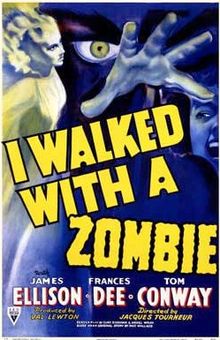 Work started on Lewton’s second film before his first was even released. Disappointed by the title given to him by the studio, Lewton wrote a rough adaptation of Jane Eyre set in the Caribbean. The woman loved by two brothers and married to one has fallen into a catatonic trance brought on by a “tropical disease.” She is, of course, really under a voodoo spell. Jessica is alternately beautiful and scary looking as she walks around in a flowing sheer white dress that gives her the appearance of floating. She has that “gone” look about her and is drawn to the sound of the voodoo drums. Her newly arrived nurse, Betsy, thinks that the local voodoo practitioner can help her and embarks with Jessica on “The Walk” through the moonlight sugar cane fields. Beautifully lit and photographed with complex characters and themes, this film moves briskly along at only 70 minutes. Director Tourneur said it was the best film he ever made.
Work started on Lewton’s second film before his first was even released. Disappointed by the title given to him by the studio, Lewton wrote a rough adaptation of Jane Eyre set in the Caribbean. The woman loved by two brothers and married to one has fallen into a catatonic trance brought on by a “tropical disease.” She is, of course, really under a voodoo spell. Jessica is alternately beautiful and scary looking as she walks around in a flowing sheer white dress that gives her the appearance of floating. She has that “gone” look about her and is drawn to the sound of the voodoo drums. Her newly arrived nurse, Betsy, thinks that the local voodoo practitioner can help her and embarks with Jessica on “The Walk” through the moonlight sugar cane fields. Beautifully lit and photographed with complex characters and themes, this film moves briskly along at only 70 minutes. Director Tourneur said it was the best film he ever made.
The Leopard Man
(Jacques Tourneur, 1943)
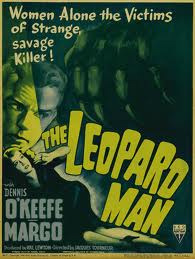 RKO didn’t understand this picture. But after the success of the first two films, the studio had learned not to question Lewton. Darkness and fear hang over a small town in New Mexico. A leopard has escaped from a nightclub show and is considered very dangerous. The story follows several characters, all women, who are to be the victims of the “leopard man.” The “walk” is employed twice as the leopard stalks his prey. Actually he’s not a leopard at all but a psychopathic killer. We don’t see the murders take place, but the suspense and the imagination make that unnecessary. Beautifully lit, dark stage sets, great camera direction, and a very effective Spanish sounding score all help Tourneur create some striking images and scenes that stay with you (including the famous blood-under-the-door scene).
RKO didn’t understand this picture. But after the success of the first two films, the studio had learned not to question Lewton. Darkness and fear hang over a small town in New Mexico. A leopard has escaped from a nightclub show and is considered very dangerous. The story follows several characters, all women, who are to be the victims of the “leopard man.” The “walk” is employed twice as the leopard stalks his prey. Actually he’s not a leopard at all but a psychopathic killer. We don’t see the murders take place, but the suspense and the imagination make that unnecessary. Beautifully lit, dark stage sets, great camera direction, and a very effective Spanish sounding score all help Tourneur create some striking images and scenes that stay with you (including the famous blood-under-the-door scene).
The Seventh Victim
(Mark Robson, 1943)
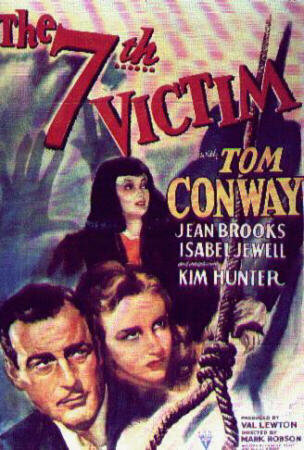 RKO split up Lewton and Tourneur thinking they, the studio, could make more money that way. Over the objections of the bosses, Lewton promoted Mark Robson to director. Again the studio didn’t like the finished product and they weren’t alone as The Seventh Victim was considered by critics at the time to be an incomprehensible mess. Mary Gibson (Kim Hunter in her first role) comes to New York in search of her sister Jacqueline, who has mysteriously disappeared. She has fallen into the clutches of a Greenwich Village satanic cult. Jacqueline has betrayed the cult and now they seek to kill her, making her their “seventh victim.”
RKO split up Lewton and Tourneur thinking they, the studio, could make more money that way. Over the objections of the bosses, Lewton promoted Mark Robson to director. Again the studio didn’t like the finished product and they weren’t alone as The Seventh Victim was considered by critics at the time to be an incomprehensible mess. Mary Gibson (Kim Hunter in her first role) comes to New York in search of her sister Jacqueline, who has mysteriously disappeared. She has fallen into the clutches of a Greenwich Village satanic cult. Jacqueline has betrayed the cult and now they seek to kill her, making her their “seventh victim.”
Dark and shadowy, paranoid, full of fear and isolation, this film has become known as “Lewton’s Dark Masterpiece.” People step in and out of shadows, speak in hushed tones and never seem to find what they are looking for. This film features some strong scenes and imagery: a creepy shower scene that presages Psycho, an off camera suicide, a great street stalking scene, and Jacqueline in the most amazing haircut you’ll see in a 1940s movie, a Cleopatra do of straight black hair and cut bangs.
The Ghost Ship
(Mark Robson, 1943)
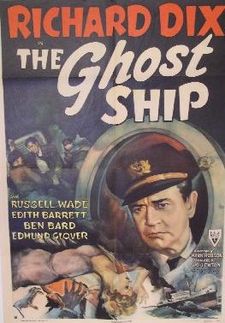 This film begins, as you would expect, with the credits rolling over a ship appearing on a fog covered sea. Before the ship can leave port the first body is found. There is a psycho killer on board; a complex character who knows that he has a dark side and feels completely justified in killing, seeing himself as an instrument of fate and destiny. The killer is revealed by one of the crew but we are unsure of which of them is really insane. Strong elements of predestination and fate, as well as the location, give this film an eerie feel. This mystery has us asking first “who?” and then “why?” But there are no answers to our questions and the final shot, in shadow only, confirms the uncertainty of the film’s protagonist.
This film begins, as you would expect, with the credits rolling over a ship appearing on a fog covered sea. Before the ship can leave port the first body is found. There is a psycho killer on board; a complex character who knows that he has a dark side and feels completely justified in killing, seeing himself as an instrument of fate and destiny. The killer is revealed by one of the crew but we are unsure of which of them is really insane. Strong elements of predestination and fate, as well as the location, give this film an eerie feel. This mystery has us asking first “who?” and then “why?” But there are no answers to our questions and the final shot, in shadow only, confirms the uncertainty of the film’s protagonist.
The Curse of the Cat People
(Robert Wise, 1944)
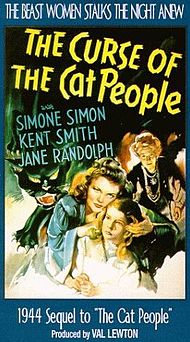 Needing another hit, RKO presented Lewton with his next title. By this time Lewton had just about had it with the stupid titles and refused to give them the sequel to Cat People that they wanted. Instead he gave them a poetic and haunting fairy tale: “The Legend of Sleepy Hollow,” a spooky house occupied by an old lady and a cat person from the original film, and a mystical imaginary friend. Simone Simon as Irena Dubrovna returns from the grave as the presence that haunts and befriends the child (Amy) of Oliver and Alice from Cat People. This was not a horror film and critics and horror fans have remained divided on it. The film that Lewton wanted to call “Amy and Her Friend” features a wonderful performance by Ann Carter as the totally sympathetic Alice in Wonderland type figure. Because of re-shoots, the film went 40% over budget. RKO was disappointed and this may have been the beginning of the end for Lewton.
Needing another hit, RKO presented Lewton with his next title. By this time Lewton had just about had it with the stupid titles and refused to give them the sequel to Cat People that they wanted. Instead he gave them a poetic and haunting fairy tale: “The Legend of Sleepy Hollow,” a spooky house occupied by an old lady and a cat person from the original film, and a mystical imaginary friend. Simone Simon as Irena Dubrovna returns from the grave as the presence that haunts and befriends the child (Amy) of Oliver and Alice from Cat People. This was not a horror film and critics and horror fans have remained divided on it. The film that Lewton wanted to call “Amy and Her Friend” features a wonderful performance by Ann Carter as the totally sympathetic Alice in Wonderland type figure. Because of re-shoots, the film went 40% over budget. RKO was disappointed and this may have been the beginning of the end for Lewton.
Isle of the Dead
(Mark Robson, 1945)
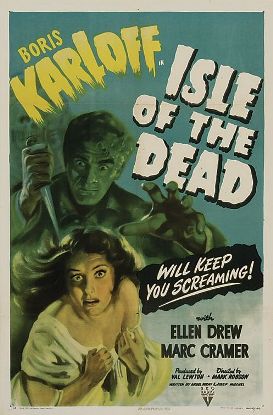 RKO wanted a real scary movie, not any of Lewton’s artsy ideas, so they signed Boris Karloff to revive their horror unit. Lewton was unsure of Karloff and did not want to have to create a part for the most recognized “monster” in the world. After a meeting between himself, Karloff, Robson, and Wise, Lewton saw that he and Karloff shared the same vision of horror. Karloff was tired of playing the same roles in Universal’s formulaic, mindless horror films and saw this as his chance to show that he was a real actor. Karloff plays Nikolas Pherides, a ruthless General in the Greek army. Cold and brutal, he walks through the battlefields full of the dead and the dying like pestilence following the war. He boats across the water to an island cemetery to visit the grave of his wife and is soon quarantined, along with the rest of the inhabitants, when the plague claims another victim. Greek mythologies of the vorvolaka (female vampires who feed on souls), the ravages of the plague, a cool graveyard, and a woman buried alive. The last act is Lewton and Karloff at their best, but still, Lewton thought this one a complete mess.
RKO wanted a real scary movie, not any of Lewton’s artsy ideas, so they signed Boris Karloff to revive their horror unit. Lewton was unsure of Karloff and did not want to have to create a part for the most recognized “monster” in the world. After a meeting between himself, Karloff, Robson, and Wise, Lewton saw that he and Karloff shared the same vision of horror. Karloff was tired of playing the same roles in Universal’s formulaic, mindless horror films and saw this as his chance to show that he was a real actor. Karloff plays Nikolas Pherides, a ruthless General in the Greek army. Cold and brutal, he walks through the battlefields full of the dead and the dying like pestilence following the war. He boats across the water to an island cemetery to visit the grave of his wife and is soon quarantined, along with the rest of the inhabitants, when the plague claims another victim. Greek mythologies of the vorvolaka (female vampires who feed on souls), the ravages of the plague, a cool graveyard, and a woman buried alive. The last act is Lewton and Karloff at their best, but still, Lewton thought this one a complete mess.
The Body Snatcher
(Robert Wise, 1945)
 RKO wanted Boris Karloff and Bela Lugosi’s names on the marquee for their next horror film. Lewton, after Isle of the Dead, now considered Karloff one of the great character actors in Hollywood but was less sure about Lugosi who, suffering from a bad back, was addicted to pain medication. But he gave him a small part that included a scene with Karloff. The Body Snatcher is based on a short story by Robert Louis Stevenson about a real life pair of grave robbers who supplied fresh cadavers to the infamous Dr. Knox in 1830s England. Lewton loved the setting and employed RKO’s sets from The Hunchback of Notre Dame. Karloff played the grave robber brilliantly in a film that seems made for him. The film was sufficiently gruesome for it to be banned in Chicago and given an objectionable rating by the Roman Catholic National Legion of Decency. It was also a big hit in America and England.
RKO wanted Boris Karloff and Bela Lugosi’s names on the marquee for their next horror film. Lewton, after Isle of the Dead, now considered Karloff one of the great character actors in Hollywood but was less sure about Lugosi who, suffering from a bad back, was addicted to pain medication. But he gave him a small part that included a scene with Karloff. The Body Snatcher is based on a short story by Robert Louis Stevenson about a real life pair of grave robbers who supplied fresh cadavers to the infamous Dr. Knox in 1830s England. Lewton loved the setting and employed RKO’s sets from The Hunchback of Notre Dame. Karloff played the grave robber brilliantly in a film that seems made for him. The film was sufficiently gruesome for it to be banned in Chicago and given an objectionable rating by the Roman Catholic National Legion of Decency. It was also a big hit in America and England.
Bedlam
(Mark Robson, 1946)
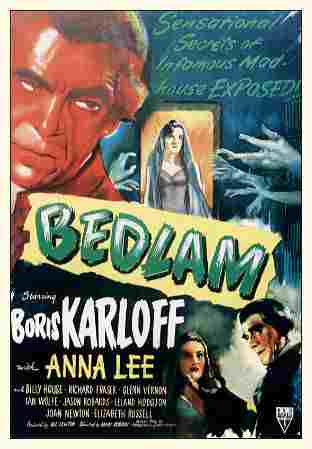 By the time Bedlam was released in 1946, the horror cycle in Hollywood had run its course. World War II had ended and audiences were ready to move on. Realism in European and American films was now the thing. Ironically, Bedlam is a social-message film, not a horror film. But RKO packaged it as such and marketed it with the usual lurid posters promising murder, mayhem, and the things that send people screaming into the night. In 1773 England, St. Mary’s Bethlehem Asylum (called Bedlam) is where the mentally ill and socially unacceptable are sent. When protagonist Nell Bowen wants to clean the place up and replace the keeper of the asylum, Master Sims (Karloff), with someone more humane, Sims uses his influence to have Bowen condemned to Bedlam. In the end, Sims falls victim to the court of lunatics in Bedlam where he meets his fate.
By the time Bedlam was released in 1946, the horror cycle in Hollywood had run its course. World War II had ended and audiences were ready to move on. Realism in European and American films was now the thing. Ironically, Bedlam is a social-message film, not a horror film. But RKO packaged it as such and marketed it with the usual lurid posters promising murder, mayhem, and the things that send people screaming into the night. In 1773 England, St. Mary’s Bethlehem Asylum (called Bedlam) is where the mentally ill and socially unacceptable are sent. When protagonist Nell Bowen wants to clean the place up and replace the keeper of the asylum, Master Sims (Karloff), with someone more humane, Sims uses his influence to have Bowen condemned to Bedlam. In the end, Sims falls victim to the court of lunatics in Bedlam where he meets his fate.
The critics were divided on this one and some were turned off by the pretentious social message angle. But today, like all Lewton’s films, it is given high praise. The final scene, reminiscent of Edgar Allan Poe, is a fitting end to Lewton’s time at RKO. Fate would ultimately be no kinder to Lewton than it was to his characters.

